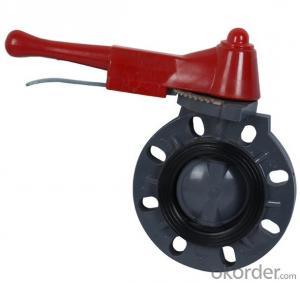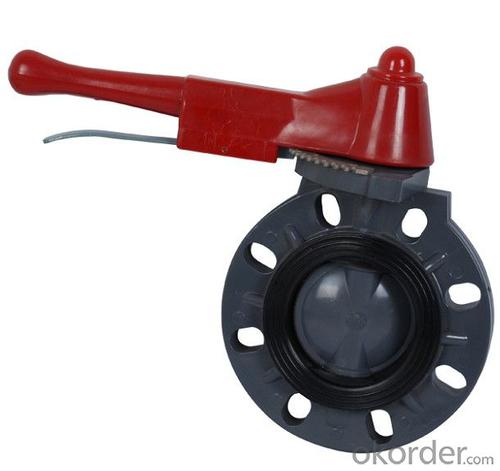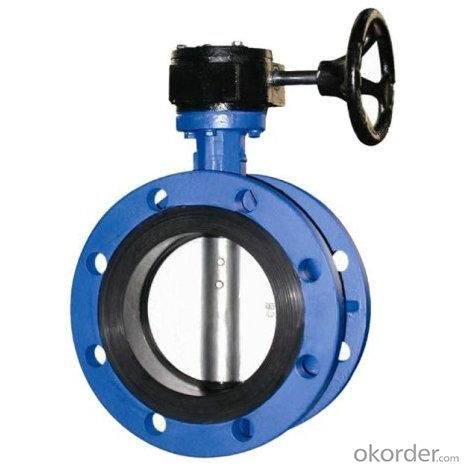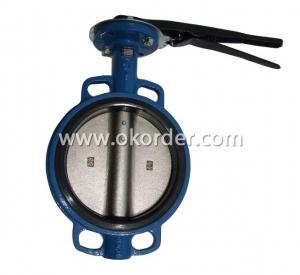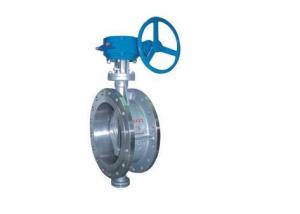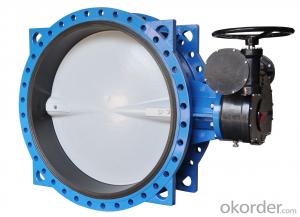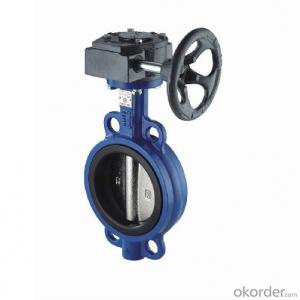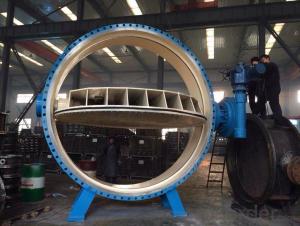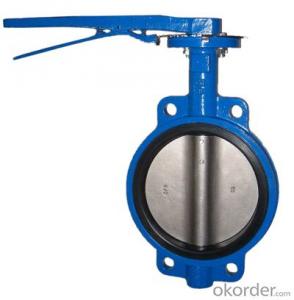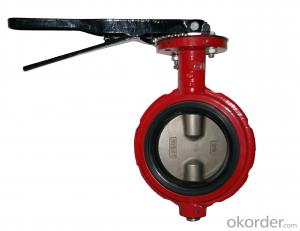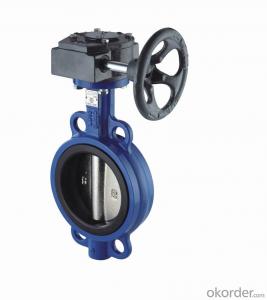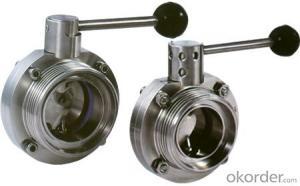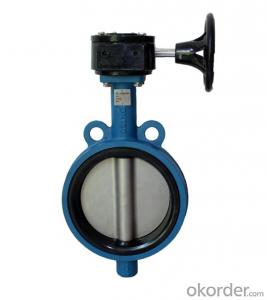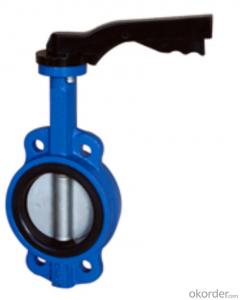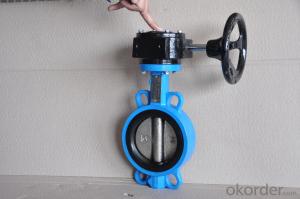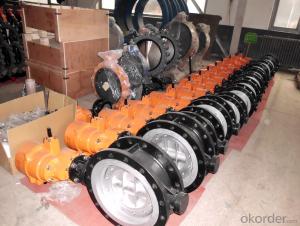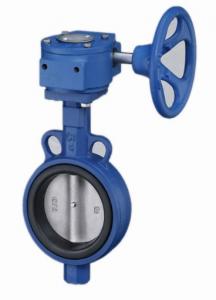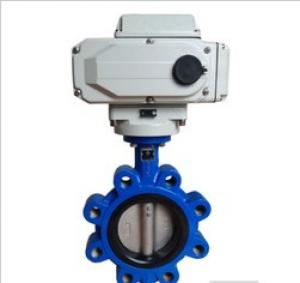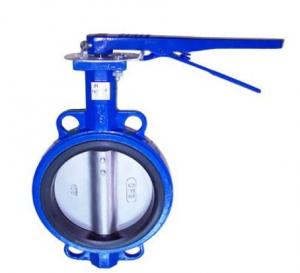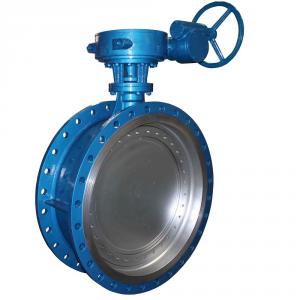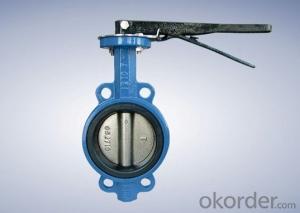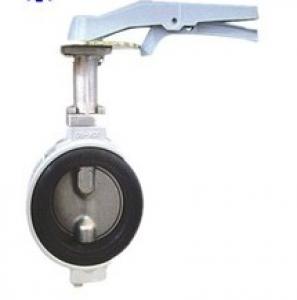Butterfly Valve Best Price Ductile Iron Wafer
- Loading Port:
- Shekou
- Payment Terms:
- TT OR LC
- Min Order Qty:
- 1 set
- Supply Capability:
- 10000 set/month
OKorder Service Pledge
OKorder Financial Service
You Might Also Like
1. Butterfly Valve Description:
A butterfly valve is a valve which can be used for isolating or regulating flow. The closing mechanism takes the form of a disk. Operation is similar to that of a ball valve, which allows for quick shut off. Butterfly valves are generally favored because they are lower in cost to other valve designs as well as being lighter in weight, meaning less support is required. The disc is positioned in the center of the pipe, passing through the disc is a rod connected to an actuator on the outside of the valve. Rotating the actuator turns the disc either parallel or perpendicular to the flow. Unlike a ball valve, the disc is always present within the flow, therefore a pressure drop is always induced in the flow, regardless of valve position.
2.Main Features of the Butterfly Valve
(1) 90° movement for full open/close position.
(2) Excellent control characteristics.Tight shut-off even after innumerable operations.
(3) Installation cost considerably reduced because of very low weight and compact design.
(4) Longer life and reliable service with minimum component wear.
(5) Renewable seats. No supplementary gasket required with the adjacent pipework.
(6) Body & Stem totally protected from service fluid.
3. Butterfly Valve Images:
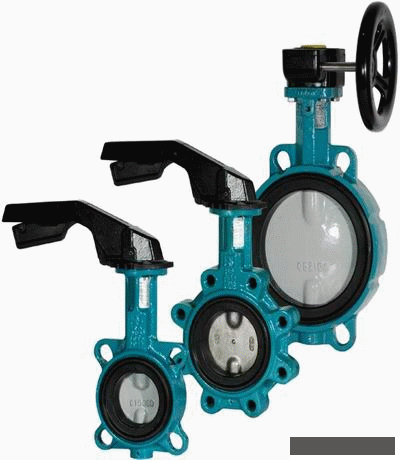
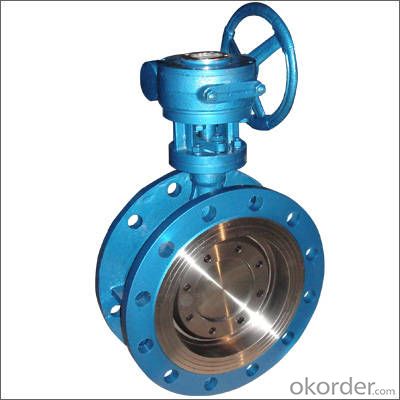
4.Butterfly Valve Specification:
BODY | DISC | STEM | SEAT | BUSHING | |
MATERIAL | WORKING PRESSURE | ||||
CAST IRON | DUCTILE IRON WITH NICKEL PLATED | CARBON STEEL | NR | -20-+85 | LUBRIZED BRONZE |
DUCTILE IRON | ALUMINUM BRONZE | STAINLESS | HYPALON | -18-+135 INSTANTANEOUS -18-+149 | PTFE |
ALUMINUM | STAINLESS STEEL | EPDM | -45-+135 INSTANTANEOUS -50-+150 | ||
CARBON STEEL | CARBON | NEOPRENE | -7-+193 INSTANTANEOUS -7-+107 | ||
STAINLESS STEEL | NBR | -12-+82 INSTANTANEOUS -12-+93 | |||
WEAR-RESISTANT RUBBER | -10-+50 | ||||
VITON | -23-+150 | ||||
HEAT-RESISTANT RUBBER | -20-+150 | ||||
PTFE | +10-+150 | ||||
5.FAQ
1. What is manual wafer butterfly valve?
Wafer style is the more common of the two and is less expensive than the lug style. The wafer style butterfly valve is just about the standard. It ís so common that no one even bothers to use the word "wafer" when ordering a butterfly valve. It is taken for granted that if a butterfly valve is ordered, a wafer style will be received.
2. How about the Installation of the Wafer Style Butterfly Valve?
Butterfly valves are installed by inserting the valve between two flanges using bolts or studs and nuts to hold it all together. This type of installation, of course, makes it impossible to disconnect just one side of the piping system from the valve. That benefit is received using the lug style valve.
3. What is the working principle of manual wafer butterfly valve?
A butterfly valve is from a family of valves called quarter-turn valves. In operation, the valve is fully open or closed when the disc is rotated a quarter turn. The "butterfly" is a metal disc mounted on a rod. When the valve is closed, the disc is turned so that it completely blocks off the passageway. When the valve is fully open, the disc is rotated a quarter turn so that it allows an almost unrestricted passage of the fluid. The valve may also be opened incrementally to throttle flow.
- Q: What do you mean, handle, butterfly valve, hard back and soft back?
- My understanding is: PTFE butterfly valve is a hard back; soft rubber seat is a soft back
- Q: What does "C" in D971F-16C DN450 RF mean for electric butterfly valves?
- Valve carbon steel -16c body 316 stainless steel -16r
- Q: Okay, so I've been thinking about trying to learn how to play my dad's baritone bugle, but I have no idea how to. If anyone had a good fingering chart for it, that would be great. The bugle has one valve and a trigger. I am a natural flute player and percussionist, so this is my first time playing a brass instrument. Needless to say I am very confused. Call me a noob, I don't care, as long as you get me a fingering chart for a 1 valve baritone bugle. Please help. :)
- We learned the scale like this on a G-D horn with no rotor just a valve. O open X valve closed O X O X O X X O
- Q: Not the cold and hot water shut off valves. The one with a tiny handle and it looks like a T. what does it do? should I mess with it?
- Sounds okorder /
- Q: What are the advantages of butterfly valves?
- B. is cheap, especially when the caliber is big;C. the resistance loss is small and the fluid decreases through pressure;
- Q: The flow ratio of area and maximum flow area of the valve is? If it refers to the opening of the valve rotation angle? Butterfly linear closure refers to the butterfly valve at constant angular velocity close? When the change trend of flow is what? These valves problem bothering me for a long time,
- Butterfly valve "opening - flow" curve in the flow of 25%-75%, that section is basically linear. That is, the opening of 40%, that flow is about 40%Butterfly valve opening degree of 0.5, should be opened 50%, that is, opening to 45 degrees;
- Q: Where are the exhaust valves, mud valves and butterfly valves?
- The exhaust valve is used for the heating of the independent heating system, central heating system, heating boiler, central air conditioning, floor heating and solar heating system.Mud valve, also known as cover valve, commonly used in urban water plants, sewage treatment plants sedimentation tank bottom discharge sludge.Butterfly valve used in furnace, coal gas, natural gas, liquefied petroleum gas, city gas, hot and cold air, chemical smelting and power generation environmental protection engineering system, conveying a variety of corrosive and non corrosive media pipeline, used to adjust and cut off the media flow.
- Q: I have put a new pressure valve and replaced both thermostat
- If it is not overheating due to a stuck thermostat or bad heating element and you changed the TP valve then it is possible you have a problem with thermal expansion. When water is heated it expands and the more it is heated the more volume it will need to expand. Since the water heater and the piping are not designed to expand the water only has one place to go (well two if count the faucet) and that is out the TP valve. This problem is not uncommon and the solution is to have an expansion tank installed on the hot water heater in the piping near the tank.
- Q: The difference between the directly buried gate and the flange valve and butterfly valve
- Buried gate also called buried gate valve, valve can be directly buried underground, built without manhole, reduce road excavation area; small well maintained road and beautiful room can reduce the difficulty of construction, reduce project cost. The directly buried soft sealing gate valve is divided into two types: telescopic type and fine fixing type, wherein, the telescopic type is divided into metal type and plastic type. In the process of construction, the telescopic type can be adjusted arbitrarily according to the distance between the buried depth of the valve and the ground, and the micro adjustment can be adjusted on the spot. The directly buried gate valve has the advantages of long-term use, no leakage, no maintenance, etc., and can effectively avoid other people switching the valve and stealing the manhole cover at will.Flange gate valve is connected to the flange gate valve, this connection is the most common way. The flange gate valve is stable and reliable when used in the pipeline, so the flange gate valve is used on the high pressure pipeline.Butterfly valve refers to the closure of parts (valve or butterfly plate) as the disk, around the valve shaft to achieve rotation and closing of a valve, the main cut off on the pipe and throttling role. Butterfly valve headstock is a disc shaped disc, in the valve body around its own axis of rotation, so as to achieve the purpose of opening or closing or regulation. Butterfly valve used in furnace, coal gas, natural gas, liquefied petroleum gas, city gas, hot and cold air, chemical smelting and power generation environmental protection engineering system, conveying a variety of corrosive and non corrosive media pipeline, used to adjust and cut off the media flow.
- Q: D341W-10P-400 butterfly valve, what does each alphanumeric letter mean?
- According to JB/T308-2004 "valve type programming method"D butterfly valve3 worm gear4 flange connection1 Structure: sealed type, central vertical plateW sealing material for valve body material10 nominal pressure PN10P body material is chromium nickel stainless steel400 shall be nominal size DN400
Send your message to us
Butterfly Valve Best Price Ductile Iron Wafer
- Loading Port:
- Shekou
- Payment Terms:
- TT OR LC
- Min Order Qty:
- 1 set
- Supply Capability:
- 10000 set/month
OKorder Service Pledge
OKorder Financial Service
Similar products
Hot products
Hot Searches
Related keywords
